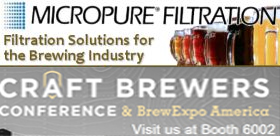SulfurGuard Filter Time Interval Explanation
CO2 filtration in the food and beverage industry is done by the Micropure SulfurGuard Filter Series. The SulfurGuard filtration system is comprised of 4 or 5 filters used in series. Many CO2 filtration system manufacturers advertise a simple replacement interval of 6 months or 1 year. The actual life of a filter is much more complicated than that arbitrary assignment.
Below is some basic information about our filter series and a simple explanation for how we come up with our time intervals for filter element replacement. The interval is figured from a formula that we created based on element testing and filter element capabilities. Below is listed the factors in the filter life formula and where each factor derived.
- Contaminants present in CO2 stream. Each application provides a different set of challenges. Each possible contaminant in the CO2 stream will present a different strain/workload for the filtration system.
- Contaminant percentage. The percentage or ppm level is factored into the life span of the filter. Each filter is rated to absorb a specific number of lbs. of a contaminant. If there is a higher level of the contaminant, then the life span will be shorter.
- Absorption factor of each element. This factor is given to us by the filter media components. We use a contaminant compatibility chart for each media. This chart will show each filter material and how much of a specific contaminant will be absorbed prior to material/filter failure.
- CO2 flow rate. The flow rate of the CO2 will have a similar effect on the life span as the contaminant percentage. The higher the flow rate/yearly consumption, the shorter the life span will be for each filter. The lower the flow rate/yearly consumption, the longer the life span will be for the filter.
- Pressure. Pressure does not affect the lifespan of the filter.
- Temperature. Temperature does not affect the lifespan of the filter. The Filters have a max Temperature of 225°F
Typical Application set up is a 5 stage setup. There are multiple filter sizes and connections available for your system. In this article, we will focus on the 2 most common sizes. There are sizes above and below what is listed in this explanation.
Stage |
Filter Type |
Filter Series |
Purpose |
1 |
Coalescing | CFCC | Removal of Liquid and oils |
2 |
Activated Carbon | CG | Absorption of aromatic carbon based contaminants |
3 |
SulfurGuard | SG | Absorption of sulfides |
4 |
Particulate | CFCC | Particulate filter |
5 |
Sterile | PSF | Sterilization of Gas for acceptable use in food and beverage application |
The CFCC series filter (stage 1 & 4) works much like a screen and is installed to remove liquid and particulate (0.01 micron). This filter does not carry a specific hour or flow change out rate because it is does not fail based on absorption. The failure would come from overloading of Particulate or liquid. Because there is no specific failure rate, we include a differential gauge with the filter to properly manage filter life. In food and beverage applications, we recommend that this filter is changed out roughly once a year. In situations where the incoming CO2 is extremely dirty, we have seen the need for a 6 month change out, but that in not common. The 6 month change out is more common in non-USA installations where incoming CO2 quality is questionable. Our rule of thumb is to replace this filter when the other 2 phases are changed out. The most accurate way to measure change out would be PSID of filter. When the PSID gets to an unacceptable rate for your application, replacement is recommended. Typical dry PSID of filter is around 1 PSID. A PSID of 3 is common with 10-20 wt. oil.
Filter Rate Examples
The CG series filter |
The SG series filter |
The PSF series filter |






